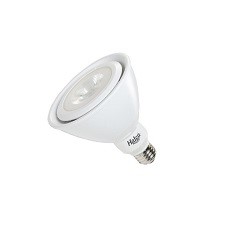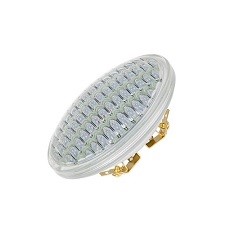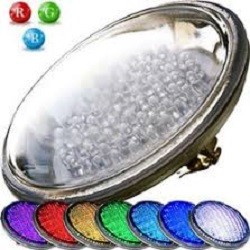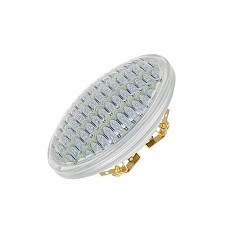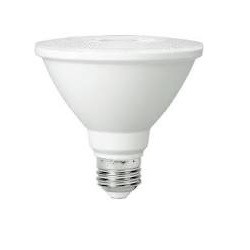What are PAR36 LED Light Bulbs Used For?
If you have ever seen a fountain with submerged lighting, odds are those were PAR36 light Bulbs underneath creating the beautiful display of lighting. LED PAR36 bulbs are primarily used as outdoor lights and can quickly add an elegant décor to any landscape setting.
Before you start retrofitting all your spotlight fixtures or underwater well lights, make sure you know a little bit about LED bulbs before you buy.
HomElectrical knows a thing or two about PAR bulbs and we’ve got the answers you need.
What is a LED PAR36 Bulb?
An LED PAR36 bulb helps control light in a precise or designated space to help produce a concentrated light intensity. Like LED PAR16, PAR20, and PAR30 bulbs, LED PAR36 bulbs are often used in recessed cans and track lights in hotels, retail spaces, offices, and restaurants.
Because PAR36 LED bulbs provide a wider beam angle, these lights are most often used in landscape lighting as well as flood lights.
Recommended Products
PAR36, PAR20, and PAR16 bulbs are great replacements for incandescent but can easily replace other LED bulbs such as BR (Bulged Reflector) bulbs due to their versatility in many different areas. Let’s look at a few ways PAR36 bulbs are more diverse than you think.
How are Light Bulbs Measured?

The number on a LED PAR Bulb refers to the diameter of the lamp measured in terms by eighths of an inch. This number can be easily converted to inches by multiplying the PAR number x 1/8 (0.125). The diameter of a bulb directly correlates to where it can be used. In this case a PAR36 bulb has a 4.5-inch diameter.
Most Common LED PAR Bulbs
PAR | DIAMETER |
16 | 2 inches |
20 | 2.5 inches |
36 | 3.75 inches |
36 | 4.5 inches |
38 | 4.75 inches |
What are the Base Types for LED PAR36 Bulbs?
We mentioned that LED PAR20 bulbs are similar in diameter to the PAR16 bulbs. The PAR36 is two sizes bigger. While a PAR36, PAR20, and a PAR16 bulb can have very similar CCT’s, Lumen Output, and Wattages, they have very different applications.
PAR36 bulbs are unique to the fact that they can be used with both indoor and outdoor fixtures. The two main differences with a PAR 36 bulb is that the beam spread, and the bulb dimension are much different than the smaller PAR Bulbs. This is important when determining the application for your PAR36 bulb.
In addition to variables in lighting display and dimensions, the PAR36 bulbs have three bulb base types to choose from. This gives a PAR36 bulbs more applications where they can be used. More base types means more types of fixtures they can be used in.
|
LED PAR36 E26 Base |
LED PAR 36 Screw Pin Led Base |
|
|
|
The base type helps determine which light fixture your bulb will fit in. However, the size of the bulb itself can delegate whether you can use an open or enclosed fixture.
Most LED PAR36 bulbs come with a standard E26 medium base but can be adjusted depending on your fixture. For example, if you currently have a BR36 light fixture with a G10 (bi-pin) socket type, you could replace it with a PAR36 GU10.
The type of base will vary from manufacturer and the specific application.
Most Common Base Types
- Edison Series
- Screw Tip Base
What is the Beam Angle for an LED PAR36 Bulb?
The beam angle of PAR36 bulbs is on the larger size, however some can be as narrow as 40 degrees. The most common beam angle is “Narrow Flood” and is designed for recessed can lighting, track lighting, and widely used for landscape lighting.
The PAR36 bulb is also an excellent choice for offices, conference rooms, and other commercial applications where downlighting is desired.
Angle Description | PAR Angle |
Very Narrow | 15° |
Narrow Spot | 16° - 36° |
Spot | 36° - 60° |
Narrow Flood | 61° - 90° |
Wide Flood | 91°- 120° |
Very Wide Flood | 160° |
LED PAR36 Bulbs Wattage and Brightness
Wattage and brightness are often misunderstood. While most people think that the higher the wattage is, the brighter the bulb will be, this is incorrect!
- The wattage of a light bulb only refers to how much power the bulb is using. The actual brightness of a light bulb is determined solely by the lumen output.
- The size of a Bulb’s dimension does not influence the brightness and there are many different bulb options. This is what makes the PAR36 bulb such a viable replacement.
Use the chart below to know exactly what bulb you need to replace your old incandescent bulbs.
Incandescent Light Bulb (watts) | LED (watts) | Lumens |
40W | 2-5W | 0-450 |
60W | 6-9W | 500-850 |
75W | 11-14W | 900-1150 |
100W | 15-17W | 1200-1650 |
Like all LED Bulbs, less watts equals less energy consumption. Less energy consumption means lower monthly energy bills. LED light bulbs use up to 90% in energy savings and can last up to 70,000 hours. They emit less heat than an incandescent bulb but can still produce the same brightness.
What is the Color Temperature for LED PAR36 Bulbs?
The hue or actual appearance of a light bulb is in refence to its color temperature, not how bright the light is. Because of PAR bulbs use reflectors, PAR bulbs typically have higher CCT and lumen outputs. This makes PAR36 bulbs great for track lighting display lighting.
The three most common color temperatures:
- Soft White: 2700K-3600K
- Bright White/ Cool White: 3500K-4100K
- Daylight: 5000K-6500K
Another common mistake is consumers confuse brightness with the color temperature (CCT) of a light bulb. The higher the CCT rating, the warmer the color temperature which make the bulb appear whiter.
Ideal Applications for LED PAR36 Bulbs
Many people are switching from PAR38 bulbs to PAR36 bulbs for outdoor lighting because they are much smaller in diameter. In addition to size, they come in different color lenses which is used in well lighting. A PAR36 bulb offers just as many CCT options than its larger counterpart but because of its versatility they can be utilized in many other ways.
Multi Colored PAR36 Bulbs | Applications | Features |
|
|
|
Applications | Features | |
|
|
|
E26 LED PAR36 | Applications | Features |
|
|
|
Recommended Reading
LED PAR bulbs come in a wide variety of size options which suit many different applications. Search our vast collection of LED PAR bulbs to find the perfect bulb for your space.
Replacing LED bulbs seems confusing at first because LED bulbs use significantly less wattage than their incandescent counterparts while emitting the same amount of brightness. Learn the wattage equivalents of incandescent and LED bulbs to make sure you replace your incandescent bulbs with the correct LED.
LED PAR Bulbs provide an energy efficient and cost effective alternative to other types of light bulbs and require very little maintenance. Learn more about LED PAR bulbs!
Different beam angles work for different situations. The farther the light fixture from the targeted area, the smaller the beam requirements you need.
Recommended Products
Receive special deals and more, right to your inbox
Receive special deals and more, right to your inbox





